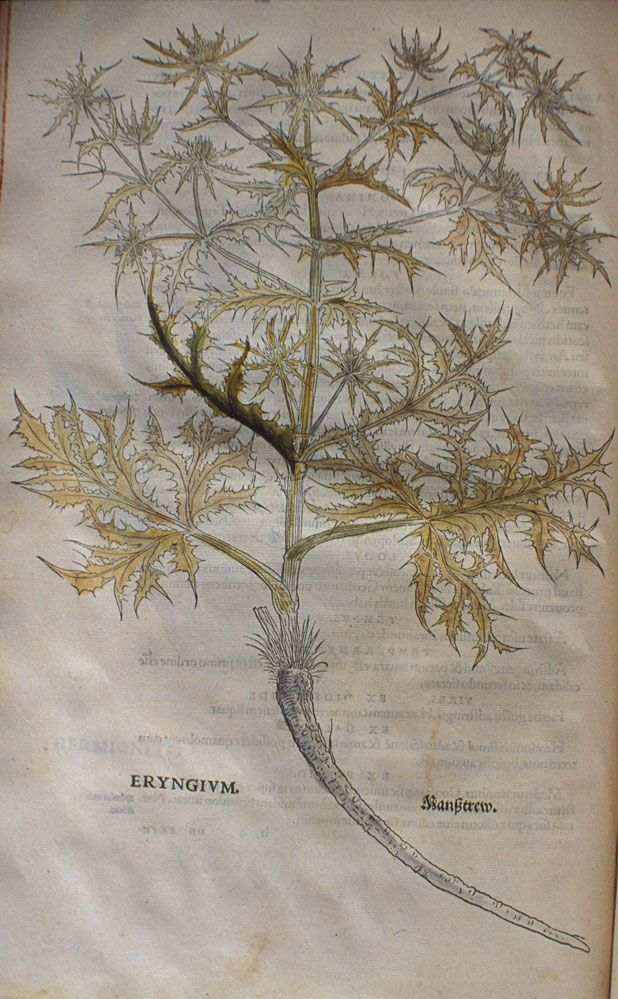Among the plants named for their admirable qualities.
Notes
Eryngium campestre L.

Eryngium campestre L.
Eryngium
Mansstrew
De historia stirpium commentarii insignes…
Basil: In Officina Isingriniana, 1542
Smithsonian Library
Eryngion
Pliny xxii. 7, § 8.
Gargantua and Pantagruel
William Francis Smith [1842–1919], translator
London, 1893
Eryngion
Clara in primis aculeatarum erynge est sive eryngion contra serpentes et venena omnia nascens. adversus ictus morsusque radix eius bibitur drachmae pondere in vino aut, si plerumque tales iniurias comitetur et febris, ex aqua. inlinitur plagis, peculiariter efficax contra chersydros ac ranas. vero omnibus contra toxica et aconita efficaciorem Heraclides medicus in iure anseris decoctam arbitratur. Apollodorus adversus toxica cum rana decoquit, ceteri in aqua. ipsa dura, fruticosa, spinosis foliis, caule geniculato, cubitali et maiore aliquando, alia albicans, alia nigra, radice odorata; et sativa quidem est, sed sponte nascitur in asperis et saxosis et in litoribus maris durior nigriorque, folio apii.
Especially famous among spinous plants is the erynge, or eryngion, that grows to counteract snake bites and all poisons. For stings and bites its root in doses of one drachma is taken in wine, or in water if (as usually happens) such injuries are also accompanied by fever. It is applied to the wounds, being a specific for those caused by amphibious snakes and frogs. Heraclides the physician is of opinion that boiled in goose broth it is more efficacious than any other remedy for aconite and other poisoning. Apollodorus would boil it with a frog for poisoning, the other authorities say in water only. The plant itself is hardy [Or “hard,” “tough.” The adjective durus has both meanings, and so much ambiguity is caused in a botanical context], bushy, with prickly leaves and jointed stem, a cubit high or occasionally taller, partly palish in colour, partly dark, and with a fragrant root. While it is a cultivated plant it also grows wild on rough, stony ground and on the sea shore, when it is more hardy and darker, with a leaf like that of celery.
The Natural History
22.08
Harris Rackham [1868–1944], translator
Cambridge, Massachusetts: Harvard University Press, 1938
Loeb Classical Library
eryngion
Eryngium, ἠρυγγιον, de ἤρυγγοζ, barbe de bouc ou de chèvre, allusion à l’aspect barbelé de la jeune pousse. — «Erynge… sive eryngion, contra serpentes et venena omnia nascent», dit Pline, XXII, 8, qui en décrit trois espèces: le blanc, notre E. campestre, L.; le noir, E. cyaneum, Sibth.; le maritime, E. maritimum, L.
Oeuvres. Tome Cinquieme: Tiers Livre
p. 353
Abel Lefranc [1863-1952], editor
Paris: Librairie Ancienne Honoré Champion, 1931
Archive.org
eryngium
thus eryngium (or by Hellenic derivation, goat’s bear) which includes sea-holly…
Complete works of Rabelais
Jacques LeClercq [1891–1971], translator
New York: Modern Library, 1936
par les admirables qualitez
Cf. encore, De latinis nominibus pour tous ces détails. Le seule exemple qui ne s’explique pas de soi-même est hieracia; «Hieracum nomen ex eo venit quod [l’epevier] succo hujus herbae oculorum obscuritatem discutiant». Eryngion (« barbe à bouc ») serait un contrepoison. Que-fait-il dans cette liste?
Le Tiers Livre
Michael A. Screech [b. 1926], editor
Paris-Genève: Librarie Droz, 1964
Eryngion
De ἤφνγγυζ, «barbe de bouc» (Pline, XXII, viii).
Œuvres complètes
p. 504, n. 21
Mireille Huchon, editor
Paris: Gallimard, 1994
par les admirables qualitez
Puisés aux mêmes sources, tour ces détails sont clairs. Comme dans la liste précédente, Rabelais termine par des exemples qu’il n’explicite pas. Hieraca, plur. de hieracion, vient de Pline, XX, 7: cette plante passe pour bénéfique aux yeux de l’épervier (dit hierax en grec). L’érynge (eryngion) passe pour exciter à l’amour (Pline, XXII, 8; Manardi, Epistolae medicinales, XII, 4): s’est -on appliqué à y retrouver eros?
Le Tiers Livre
p. 454
Jean Céard, editor
Librarie Général Français, 1995
eryngium
eryngium. [modern Latin, formed on Latin eryngion, adopted from Greek hruggion.]
A hardy herbaceous perennial plant of the genus so called, belonging to the family Umbelliferæ, and bearing blue or white flowers.
1578 Henry Lyte, tr. Dodoens’ Niewe herball or historie of plantes iv. 518 Two kindes of Eryngium, the one called the great Eryngium, or Eryngium of the Sea, and the other is called but Eryngium onely.
1616 Richard Surflet and G. Markham, translators Estiennne and Liebault’s Maisson rustique, or the countrie farme 203 Eringium groweth in an vntilled, rough, and drie ground.
1626 Francis Bacon Sylva sylvarum; or a naturall historie (1631) §53 Some few Slices of Eryngium Roots.
eryngo [Immediate source uncertain: perhaps a corrupt adoption of Ital. or Spanish eringio, adaptation of Latin eryngion, adopted from Greek hruggion, diminutive of hruggoj the name of this plant, also a goat’s beard.]
The candied root of the Sea Holly (Eryngium maritimum), formerly used as a sweetmeat, and regarded as an aphrodisiac. Obsolete b In later use, the plant itself, or any other of the same genus. (In this sense the Latin eryngium was used by earlier writers.)
1598 Shakespeare Merry Wives of Windsor v. v. 23 Let it… haile kissing Comfits, and snow Eringoes.
1599 John Marston The scourge of villanie, three books of satyres i. iii. 181 Camphire and Lettuce chaste Are clean casheird, now Sophi Ringoes eate.
1616 R. C. Times’ Whis. vi. 2771 Candid eringoes, and rich marchpaine stuff.
C. 1630 Risdon Surv. Devon §277 (1810) 288 Sea-holly groweth plentifully, whose roots are called eringo.